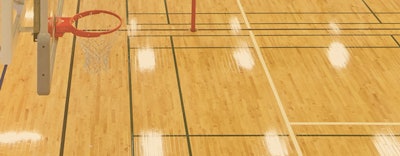
Selecting a gymnasium floor is a big decision. The initial costs are significant, as is the expense of maintaining the surface. Here are a few things to consider when shopping for flooring.
PRIMARY USE
The first order of business when considering a gymnasium floor is how the space will be used. For instance, a recreation gym may be a multipurpose space, hosting physical education classes, concerts and potlucks, while a collegiate gymnasium may only host basketball and volleyball games. The types of spills and wear-and-tear expected will determine what kind of surface is right for the space, the kind of daily care the floor will require, and how long the floor will last.
LIFESPAN
Both wood and poured urethane flooring have life expectancies of around 40 years, while modular flooring and other synthetic options may have shorter lifespans but require less maintenance. Ultimately, factors such as frequency of use and the types of activity that take place on the floor will factor heavily into the longevity of the surface.
RELATED: Addressing Surface Condensation in Multipurpose Arenas
INITIAL COST
Initial investment for a maple floor is approximately $10 per square foot. Modular and rubber flooring will run about $5.50 and $9 per square foot, respectively. A poured urethane floor costs approximately $8 per square foot.
MAINTENANCE
All flooring, whether wood or synthetic, requires basic maintenance. Daily sweeping, proper gymnasium heating and cooling, ventilation, prompt cleanup of spills, and regular inspection for expansion or shrinkage as the weather changes — all are important facets in the regular care of a gymnasium floor. Over the lifespan of the surface, wood flooring will require major maintenance, including sanding down to bare wood, repainting and resurfacing every 10 to 15 years. Poured urethane will also require resurfacing every 15 years. Modular and other synthetic flooring systems may require less major maintenance but have shorter lifespans.
RELATED: PRODUCT SPOTLIGHT 2018: Gymnasium Products and Indoor Surfaces
CHOOSING A SUBFLOORING SYSTEM
There are three primary types of subflooring systems — floating, fixed and anchored — and myriad variations of each. Subflooring can affect everything from moisture retention to shock absorption and athlete safety. It's best to speak with a professional about such things as: Who will be using this floor? What activities will be performed on the surface? How often will the facility be used in an average year? Is the facility going to be subjected to long idle periods?
This article originally appeared in the April 2018 issue of Athletic Business with the title "Purchasing Guide: What you need to know about buying gymnasium flooring." Athletic Business is a free magazine for professionals in the athletic, fitness and recreation industry. Click here to subscribe.




































